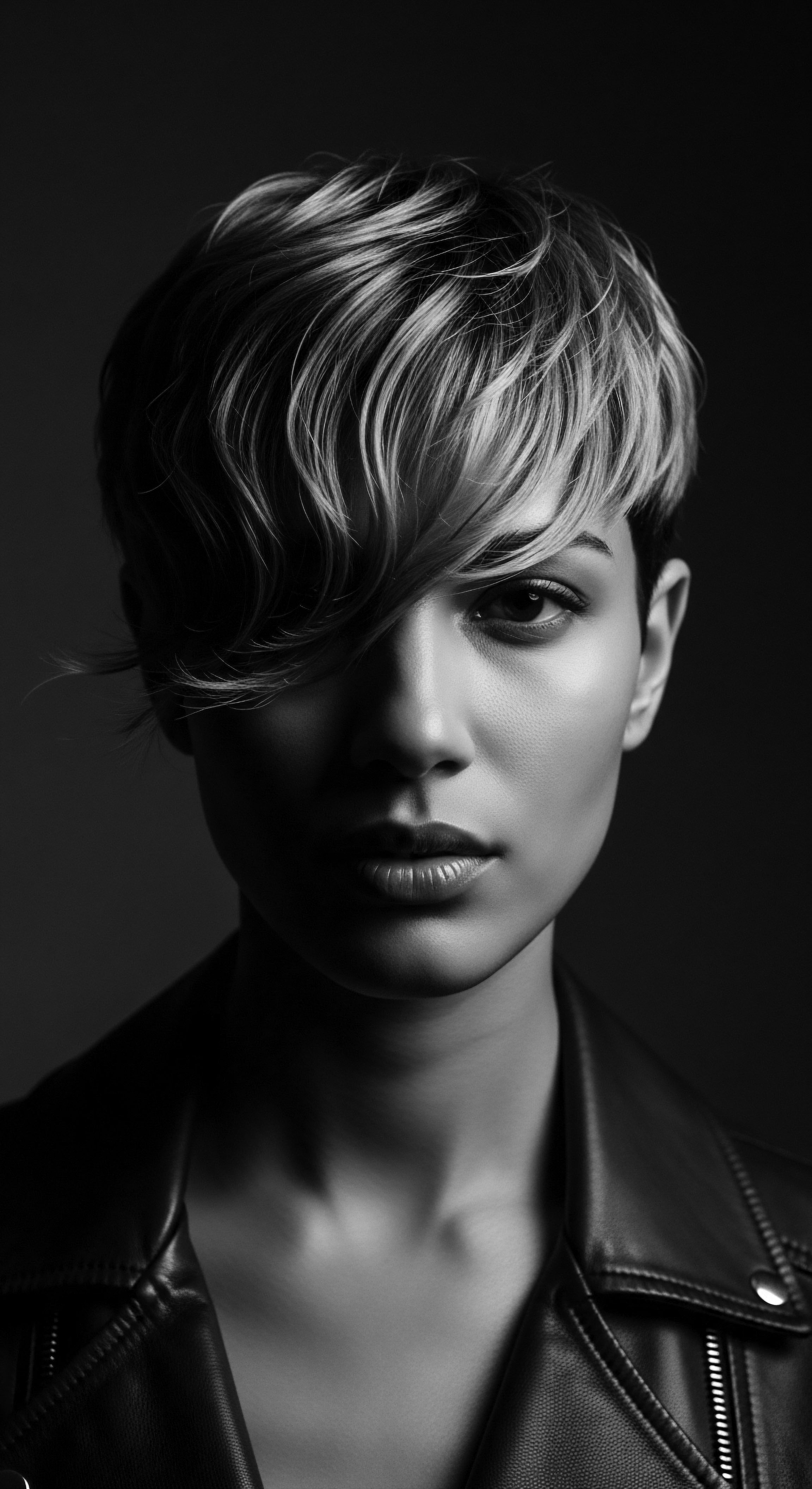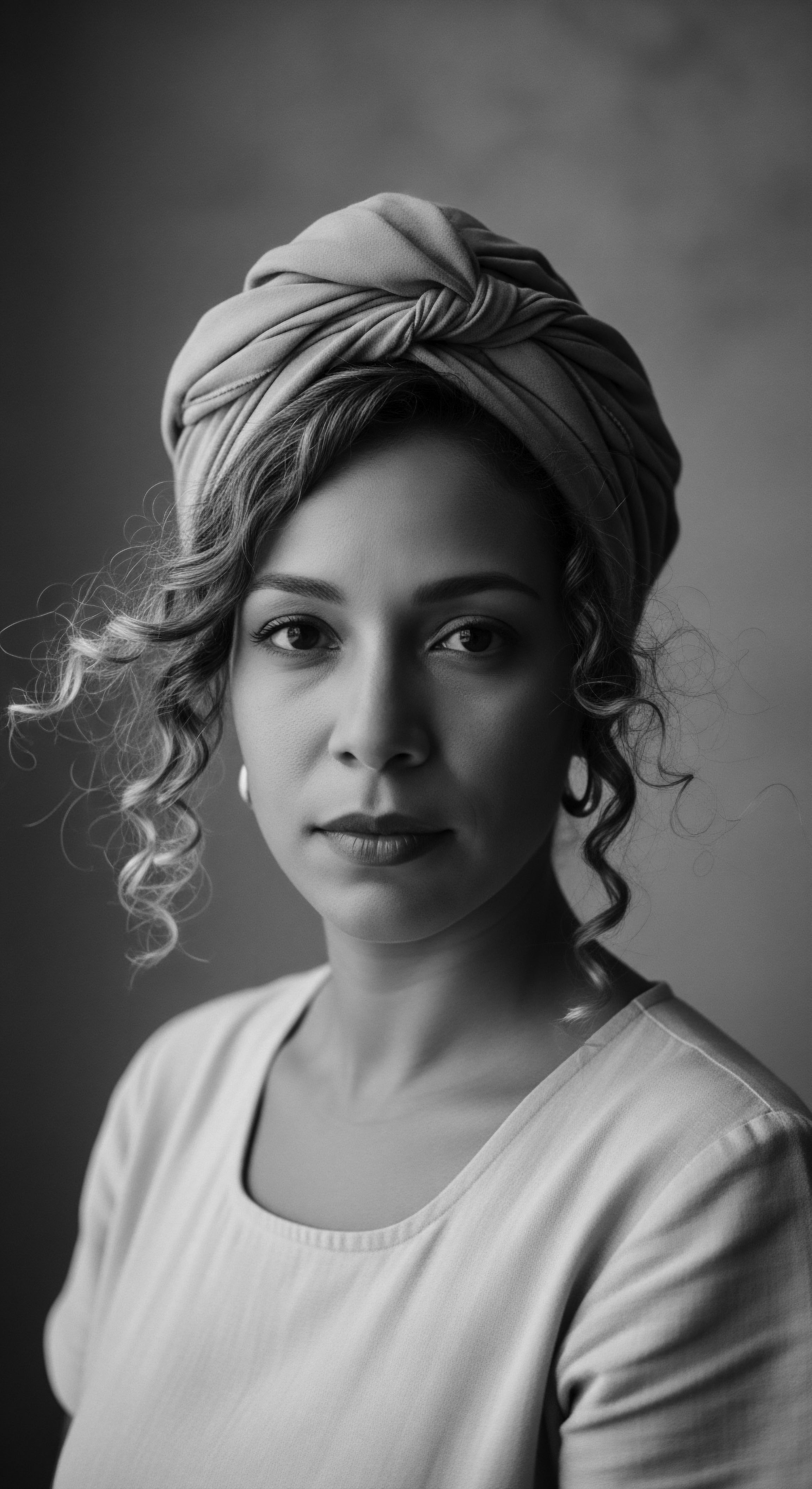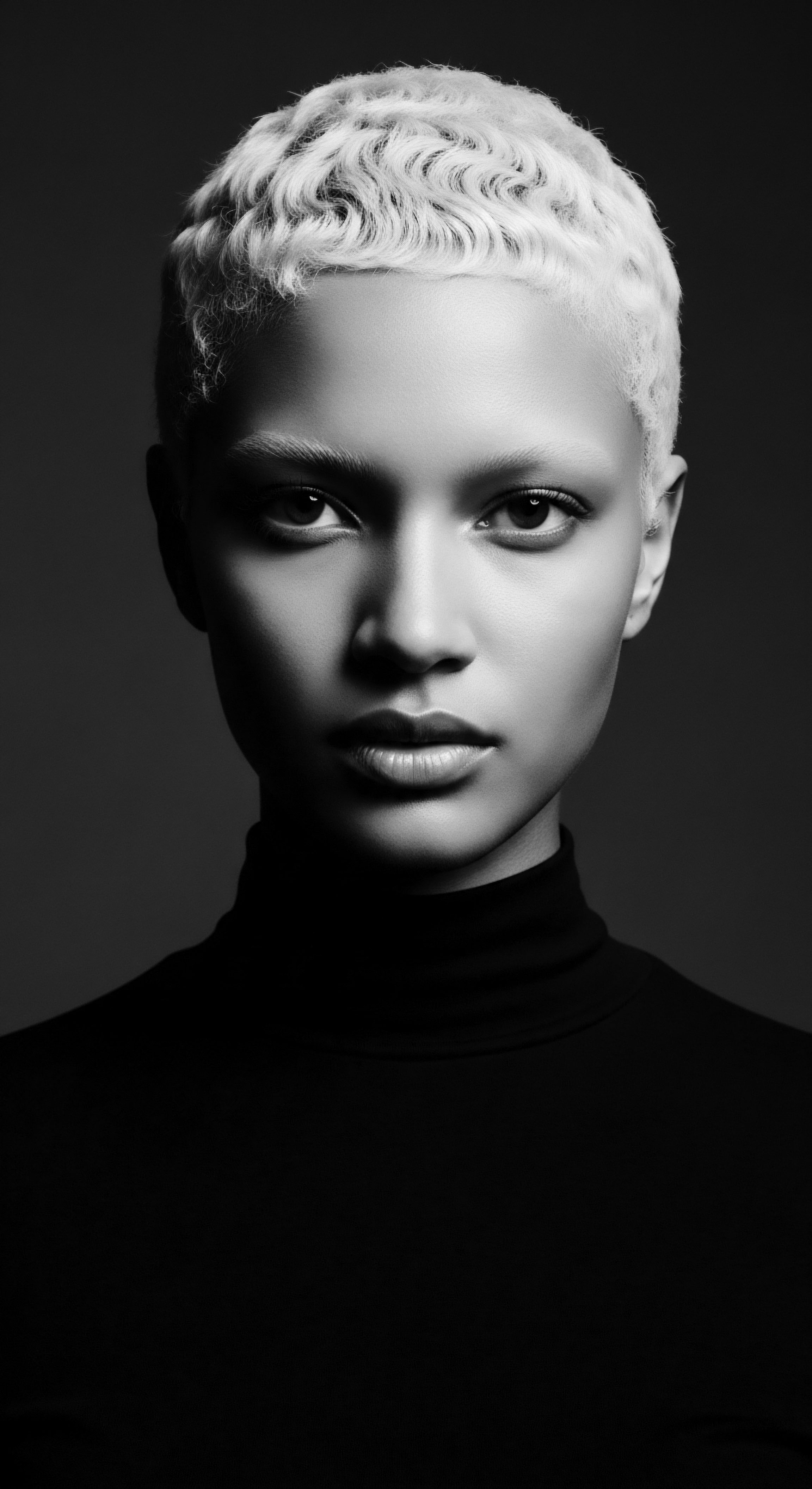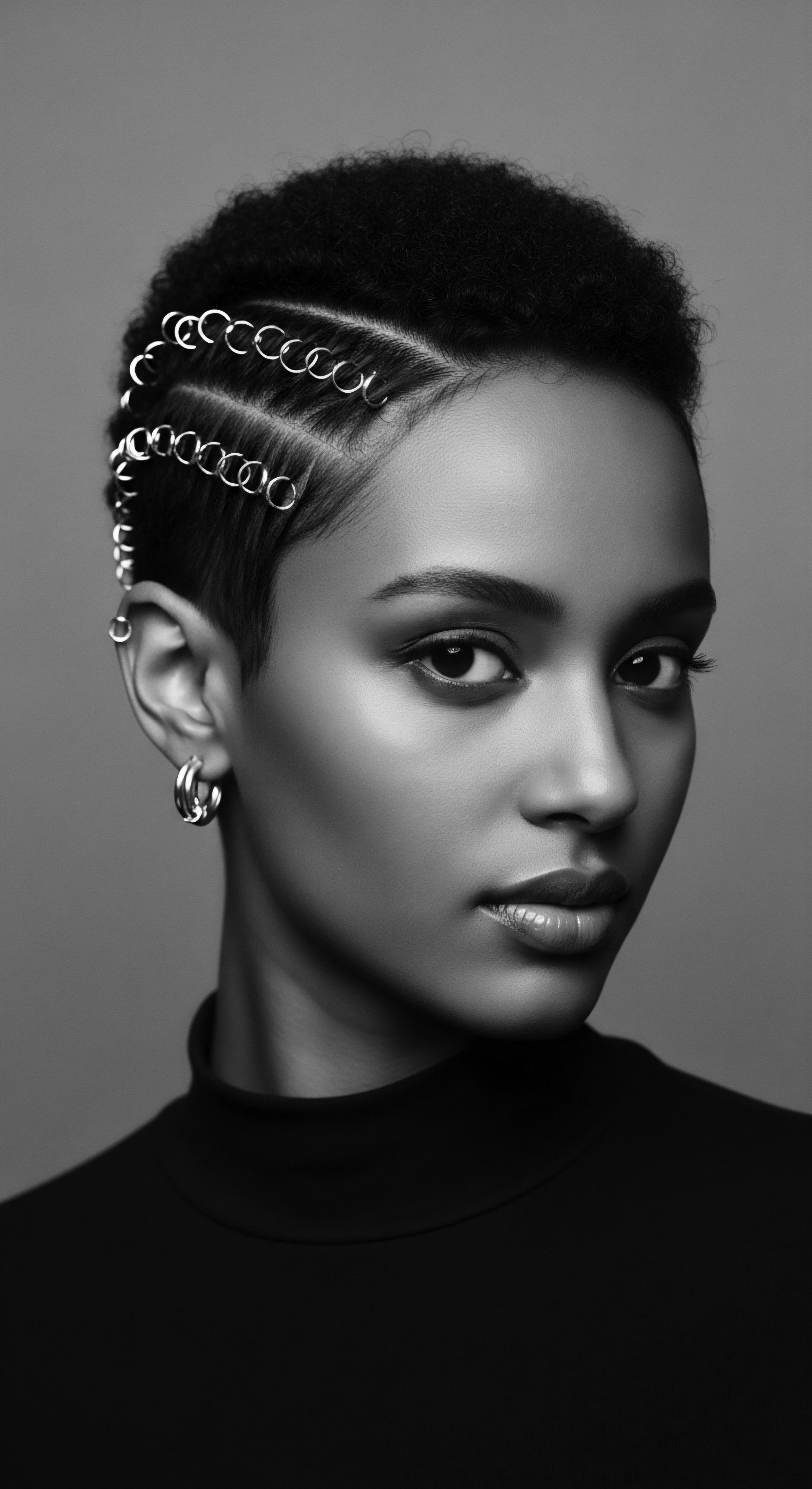
Roots
To stand here, at the precipice of understanding textured hair, is to embark upon a profound pilgrimage, a return to the very origins of its being. We consider a strand not merely as protein and pigment, but as a living scroll, inscribed with ancestral memory, carrying the echoes of millennia. Does the rich tapestry of cultural practices indeed fortify textured hair against the ravages of harm? The answer is not whispered lightly; it resonates from the collective wisdom of generations, a deep hum from the source.
Each curl, each coil, a testament to enduring legacies, whispers secrets of fortitude drawn from the hands that once tended it, the herbs that nourished it, the rituals that elevated it beyond mere adornment. The journey into its inherent resilience begins not in a laboratory, but in the hallowed grounds of collective memory.

Echoes from the Source
The very architecture of textured hair, its unique helical twists, varying diameters, and diverse curl patterns—from broad waves to tightly wound Z-patterns—renders it distinct from straight hair. This structure, a marvel of biological precision, provides both its breathtaking beauty and its predispositions. The points where the hair strand bends or coils represent areas of mechanical weakness.
This inherent structural characteristic, while creating stunning visual diversity, also means textured hair requires a specific understanding of its needs to withstand external stressors. From the earliest human civilizations, communities observed these traits, formulating systems of care that became interwoven with daily existence, forming a heritage of profound insight.
Our ancestors, living intimately with the rhythms of nature, observed the effects of environment, diet, and spiritual well-being on hair. Their understanding, forged through observation and communal knowledge, predated modern scientific instruments, yet it often aligned with what contemporary trichology now confirms. The emphasis on gentle manipulation, the use of natural emollients, and the very concept of protective styling were not accidental discoveries; they were intuitive responses to hair’s physiological demands, interpreted through a lens of holistic wellness and deep cultural reverence.
For instance, the use of shea butter, a staple across many West African societies, was not simply for moisturizing; it was a revered ingredient, believed to offer spiritual shielding alongside its emollient properties. This duality of purpose, where practical care met spiritual devotion, deeply underscores hair’s placement in ancestral life.
Cultural practices, born from intimate observation and communal wisdom, have always recognized textured hair’s unique structure and its inherent need for gentle, consistent tending.

Lineage of Hair Anatomy and Care
To truly grasp how cultural practices shape resilience, we must first appreciate the elemental biology. Textured hair typically has an oval or elliptical follicle, causing the hair shaft to grow in a curvilinear fashion. This curvature can lead to reduced strength at the bend points, making it prone to breakage if mishandled. Furthermore, the cuticle layers—the outermost protective scales—may not lie as flat as on straight hair, which can leave the cortex more vulnerable to moisture loss and external aggressors.
This physiological truth was intuitively understood by those who lived with and cared for textured hair throughout history. Their responses became the foundational practices of hair heritage.
Consider the ancient Egyptians, whose elaborate hairstyles and hair care rituals are well documented. While often associated with straight hair in popular imagery, archaeological finds and artistic depictions reveal a broad spectrum of hair types, including coiled textures, among various societal strata (Bianchi, 2017). Their use of oils, particularly castor oil and moringa oil, for both scalp health and hair conditioning, demonstrates an early recognition of the need for lubricity and moisture retention, vital for hair susceptible to dryness. These practices, part of a larger beauty and hygiene regimen, became deeply embedded in their cultural identity, reflecting status, spirituality, and well-being.
The nomenclature of textured hair today, while seemingly modern, often carries the vestiges of historical classifications, some of which inadvertently reflect colonial biases that once pathologized non-straight hair. Understanding this historical context helps us appreciate how cultural practices then became not just methods of care, but acts of affirmation and resistance. Traditional terms, often localized and descriptive, carried a respect for the hair’s natural inclination, in stark contrast to later attempts to homogenize or “manage” it into European ideals. The celebration of the natural curl, for example, has historical roots in many African societies, where particular textures were associated with specific ethnic groups, spiritual roles, or rites of passage.

Ancestral Lexicon of Strands
Each culture possessed its own rich vocabulary for hair textures, styles, and treatments. These terms were not arbitrary; they often mirrored the intimate relationship between the people and their environment, their spiritual beliefs, and their social structures. For the Yoruba people of West Africa, hair was often seen as a conduit between the physical and spiritual realms, and hairstyles could communicate marital status, age, or even invoke divine favor.
This belief system naturally extended to the care of hair, viewing it as a sacred entity requiring respectful interaction. The resilience imparted by these practices was not just structural, but also spiritual and psychological.
- Oils ❉ Many African and diasporic cultures traditionally employed a variety of plant-based oils, such as Shea Butter (from the karite tree), Palm Oil, and Argan Oil, for their emollient properties, recognizing their ability to seal moisture within the hair shaft and impart a protective barrier.
- Herbs ❉ Botanical ingredients like Fenugreek, Amla, and various indigenous barks were steeped or ground into pastes, used for their cleansing, strengthening, and conditioning properties, often applied as hair rinses or masks.
- Clays ❉ Mineral-rich clays, such as Rhassoul Clay from Morocco, served as gentle cleansers that could draw out impurities without stripping natural oils, maintaining the hair’s delicate moisture balance.
The growth cycle of textured hair, while fundamentally similar to all human hair, can be affected by cultural practices. Practices that minimize tension, chemical processing, and excessive heat support the anagen (growth) phase and reduce premature entry into the catagen (transition) or telogen (resting) phases. Conversely, historical practices involving harsh straightening agents or tight traction styles could lead to irreversible follicle damage over time. The historical record, therefore, reveals a continuum of choices—some enhancing hair’s innate capabilities, others inadvertently compromising it—all shaped by the prevailing cultural winds and evolving beauty ideals.

Ritual
Stepping from the foundational echoes into the tangible present, we encounter the living heart of cultural influence ❉ the ritual. These are not merely actions, but patterned behaviors imbued with intention, community, and memory, passed down through the ages. The very act of caring for textured hair—whether through a grandmother’s nightly braiding, a sister’s shared detangling session, or a collective styling for celebration—is a ritual that shapes its physical resilience. How do these time-honored practices, refined over centuries, bestow fortitude upon strands inherently susceptible to dryness and breakage?

The Hands That Tend
Central to the resilience imparted by cultural practices is the philosophy of gentle manipulation. Textured hair, with its unique structure, requires a delicate touch. Throughout generations, mothers, aunts, and community elders have imparted methods of handling that prioritize preservation over force.
This often begins with detangling, where wide-toothed combs or fingers are used from ends to roots, slowly and methodically, to avoid tearing the delicate strands. This methodical approach is a learned behavior, a ritual passed down, standing in stark contrast to the aggressive brushing often seen with straighter hair types.
Consider the concept of “hair oiling” prevalent in many South Asian and African communities. This practice involves regularly massaging oils, often infused with herbs, into the scalp and along the hair shaft. Beyond its physical benefits—lubricating the hair, reducing friction, and promoting scalp circulation—the act itself is a moment of connection.
It is often performed by a family member, a quiet bonding ritual that reinforces familial ties and the importance of self-care. This consistent application of emollients helps to mitigate the impact of environmental stressors and styling, creating a protective sheath around each strand, which, over time, contributes significantly to its tensile strength and flexibility.

Protective Styling An Ancestral Shield?
Perhaps the most powerful manifestation of cultural practices influencing textured hair’s resilience lies in the tradition of protective styling. Styles like braids, twists, cornrows, and locs were not simply aesthetic choices; they served a deeply practical purpose ❉ safeguarding the hair from environmental exposure, mechanical friction, and the rigors of daily life. By tucking away delicate ends and minimizing manipulation, these styles allowed hair to retain moisture, reduce breakage, and promote healthy growth. This strategic enclosure of the hair shaft directly combats the structural vulnerabilities inherent in textured hair.
The historical reach of protective styling is expansive. In ancient African kingdoms, intricate braiding patterns communicated social status, tribal affiliation, and marital status. These styles, often taking hours or even days to create, were communal events, fostering social cohesion.
The meticulousness required for these styles, passed from one generation to the next, ensured the hair was handled with the utmost care, a practice that inherently supported its strength. The enduring appeal and utility of these styles today stand as a testament to their inherent wisdom.
Protective styling, a widespread cultural practice, acts as an ancestral shield, safeguarding textured hair by minimizing external stressors and promoting length retention.
| Traditional Style Cornrows |
| Cultural Origin Many African societies (e.g. Nigeria, Ethiopia) |
| Resilience Benefit Hair is braided close to the scalp, protecting the entire length from environmental damage and reducing daily manipulation, thus preventing breakage. |
| Traditional Style Box Braids |
| Cultural Origin Ancient Egypt, various African regions |
| Resilience Benefit Individual sections of hair are braided from the root, allowing for versatility while keeping hair neatly contained and ends protected. |
| Traditional Style Bantu Knots |
| Cultural Origin Zulu people of Southern Africa |
| Resilience Benefit Hair is sectioned, twisted, and wrapped into small knots, providing deep conditioning and curl definition while preventing tangles and snags. |
| Traditional Style These styles represent a living heritage of care, actively promoting the longevity and well-being of textured strands. |

Nighttime Sanctuary and Bonnet Wisdom
The transition from day to night introduces another vital aspect of cultural care rituals ❉ nighttime protection. For textured hair, friction against cotton pillowcases can lead to dryness, frizz, and breakage. The invention and widespread adoption of silk or satin head coverings—bonnets, wraps, scarves—across Black and mixed-race communities represents a direct cultural response to this vulnerability. These coverings create a smooth, low-friction surface, preserving moisture and preventing tangles as one sleeps.
This seemingly simple practice, passed down through generations, has a profound impact on maintaining the hair’s integrity day after day, contributing significantly to its long-term health. It is a quiet revolution, a common thread in countless homes.
The tradition of using hair accessories extends beyond sleep. Head wraps, for instance, are not only fashion statements or religious observances; they also serve as protection from the elements—sun, wind, and dust—which can all dehydrate and damage hair. The layered meaning of these accessories, simultaneously utilitarian and expressive of identity, underscores the holistic understanding of hair care within many cultural contexts. They represent a continuum of protection, from the most intimate moments of rest to public expressions of style.

Relay
The journey from the elemental root to the ritualistic tending finds its complex expression in the relay—the ongoing interplay of knowledge, adaptation, and identity. Here, the profound connection between cultural practices and textured hair’s capabilities finds its most sophisticated articulation, extending beyond mere physical protection into the realms of physiological adaptation and psychological well-being. How deeply do these inherited wisdoms intertwine with our modern understanding of hair science, strengthening its very fabric?

Physiological Resonance of Traditional Practice
The sustained practice of ancestral hair care rituals can, over time, foster an environment conducive to robust hair growth and health, subtly influencing the hair’s physiological resilience. For example, regular scalp massages, a component of many traditional oiling practices, enhance blood circulation to the hair follicles. Improved circulation delivers essential nutrients and oxygen more efficiently to the dermal papilla, the base of the follicle responsible for hair growth. While the hair shaft itself is technically dead, the health of the follicle, and thus the strength and quality of the hair it produces, is profoundly influenced by its environment.
Moreover, the consistent use of natural, emollients and humectants—ingredients like Jojoba Oil, Coconut Oil, Aloe Vera, and honey, long revered in cultural contexts—provides a lipid barrier that minimizes trans-epidermal water loss from the scalp and hair. This consistent hydration, coupled with the reduction of mechanical stress through gentle handling and protective styles, contributes to a less brittle hair strand, one more capable of resisting breakage under tension. The cumulative effect of these practices is not simply cosmetic; it represents a physiological advantage, an intrinsic fortitude built layer by careful layer.

Can Ancestral Ingredients Build Hair’s Intrinsic Strength?
Specific ancestral ingredients, steeped in cultural lore, possess properties that modern science increasingly validates as beneficial for hair integrity. Take the example of rice water, a fermentation product used for centuries by the Yao women of Huangluo Village in China. Their tradition of rinsing hair with fermented rice water is credited for the remarkable length and strength of their hair, often reaching several feet (Mittal, 2017).
Scientific examination suggests that fermented rice water is rich in inositol, a carbohydrate that can penetrate damaged hair and repair it from the inside out, remaining in the hair even after rinsing. This provides a measurable, internal strengthening effect, making the hair more elastic and less prone to breakage.
Another powerful instance lies in the use of Ayurvedic herbs within Indian hair care traditions. Ingredients like Bhringraj (Eclipta prostrata) and Brahmi (Bacopa monnieri), when infused in oils, are believed to strengthen hair roots and reduce hair fall. Research into these botanicals often points to their antioxidant and anti-inflammatory properties, which contribute to a healthier scalp environment, thereby supporting the growth of stronger, more resilient hair strands. The continuous application of these herbal elixirs, often through elaborate rituals, provides prolonged exposure to beneficial compounds, cumulatively fortifying the hair.
The knowledge embedded in these traditions, passed orally and through demonstration, formed comprehensive systems of holistic well-being. Hair care was never isolated; it was part of a larger continuum of self-care, diet, and spiritual harmony. A well-nourished body, sustained by traditional diets rich in vital nutrients, naturally contributes to the health and strength of hair from within. This internal fortification complements the external protective practices, creating a dual layer of resilience.
The continuous application of ancestral care rituals and ingredients provides a physiological foundation, creating stronger, more resilient hair strands from root to tip.
The interplay of environmental factors and cultural adaptation also shapes hair’s resilience. Communities living in arid climates, for instance, developed practices centered on intense moisturization and scalp protection, using heavier oils and intricate headwraps to combat dehydration. Those in humid regions might have prioritized cleansing routines and lighter protective styles to manage moisture overload. These localized adaptations, honed over countless generations, represent sophisticated biological and cultural responses to environmental challenges, ultimately enhancing the hair’s durability within its specific context.
| Ancestral Practice Regular Oiling and Scalp Massage |
| Traditional Belief/Purpose To nourish, promote growth, and offer spiritual protection. |
| Modern Scientific Link to Resilience Increases blood circulation to follicles, delivers nutrients, lubricates hair shaft, reduces friction, seals moisture, and offers anti-inflammatory benefits to the scalp. |
| Ancestral Practice Protective Styling (braids, twists) |
| Traditional Belief/Purpose To maintain neatness, signify status, and shield hair. |
| Modern Scientific Link to Resilience Minimizes mechanical manipulation, reduces breakage, protects ends from environmental damage, and facilitates moisture retention. |
| Ancestral Practice Natural Ingredient Use (e.g. Rice Water) |
| Traditional Belief/Purpose For strength, shine, and length. |
| Modern Scientific Link to Resilience Provides inositol which repairs damaged hair from within, strengthens the hair shaft, and increases elasticity. |
| Ancestral Practice The enduring efficacy of ancestral methods often finds validation in contemporary scientific inquiry, reaffirming their inherent value for hair fortitude. |

Resilience As Identity And Resistance
Beyond the biophysical, cultural practices impart resilience in a deeply psychological sense. For Black and mixed-race communities, whose hair has historically been a site of contention, control, and misrepresentation, the act of honoring and tending to textured hair becomes an act of self-affirmation and resistance. The meticulous care of natural hair, the passing down of styling techniques, the communal gatherings around hair braiding—these rituals reinforce a positive self-image and a profound connection to heritage. When one feels confident and affirmed in their natural hair, they are less likely to subject it to damaging processes driven by external pressures, thus protecting its physical integrity.
This intangible resilience, born from cultural pride and collective identity, is perhaps the most powerful influence of all. It champions the inherent beauty of textured hair, fostering a mind-set that values its natural inclinations. This shift in perspective, cultivated through cultural reclamation and celebration, directly impacts how individuals interact with their hair, leading to gentler handling, acceptance of its natural state, and a pursuit of wellness that honors its unique characteristics. The legacy of care, therefore, becomes a legacy of enduring strength, in every sense of the word.

Reflection
We stand, then, at a confluence where ancient wisdom meets contemporary insight, where the profound connection between cultural practices and textured hair’s endurance against harm becomes irrefutable. The answers are not found in a single revelation, but in the intricate dance of inherited knowledge, communal ritual, and the sheer tenacity of self-affirmation. From the elemental biology of the strand, understood intuitively by ancestors who lived intimately with nature, to the deliberate acts of protective styling and holistic nourishment, each thread contributes to a strength that goes beyond the cuticle and cortex.
The journey of textured hair is, ultimately, a living archive—a testament to human ingenuity, cultural perseverance, and an unbreakable spirit. Roothea’s ‘Soul of a Strand’ ethos reminds us that every coil, every twist, holds stories of ingenuity, resilience, and belonging. The cultural practices passed through generations are not relics of a distant past, but vital, dynamic forces that continue to shape the very resilience of textured hair today, affirming its rightful place as a crown of heritage.

References
- Bianchi, R. S. (2017). Hair and Headwear. In J. Dieleman & W. Wendrich (Eds.), UCLA Encyclopedia of Egyptology. Los Angeles.
- Mittal, A. (2017). Hair Strengthening Effect of Fermented Rice Water. International Journal of Pharmacy & Life Sciences, 8(8), 5433-5437.
- Walker, A. (2009). Hair Story ❉ Untangling the Roots of Black Hair in America. St. Martin’s Press.
- Byrd, A. D. & Tharps, L. D. (2001). Hair Story ❉ Untangling the Roots of Black Hair in America. St. Martin’s Press.
- Gittens, S. (2015). The Science of Black Hair ❉ A Comprehensive Guide to Textured Hair Care. Self-published.
- Dermatology Clinic of Cleveland Clinic (2020). Hair Follicle Anatomy and Hair Growth Cycle. Cleveland Clinic.
- Opoku-Agyeman, A. & Oduro-Adabor, D. (2021). Traditional African Hair Care Practices and the Health of Hair. Journal of Dermatology and Cosmetology, 5(2), 23-28.
